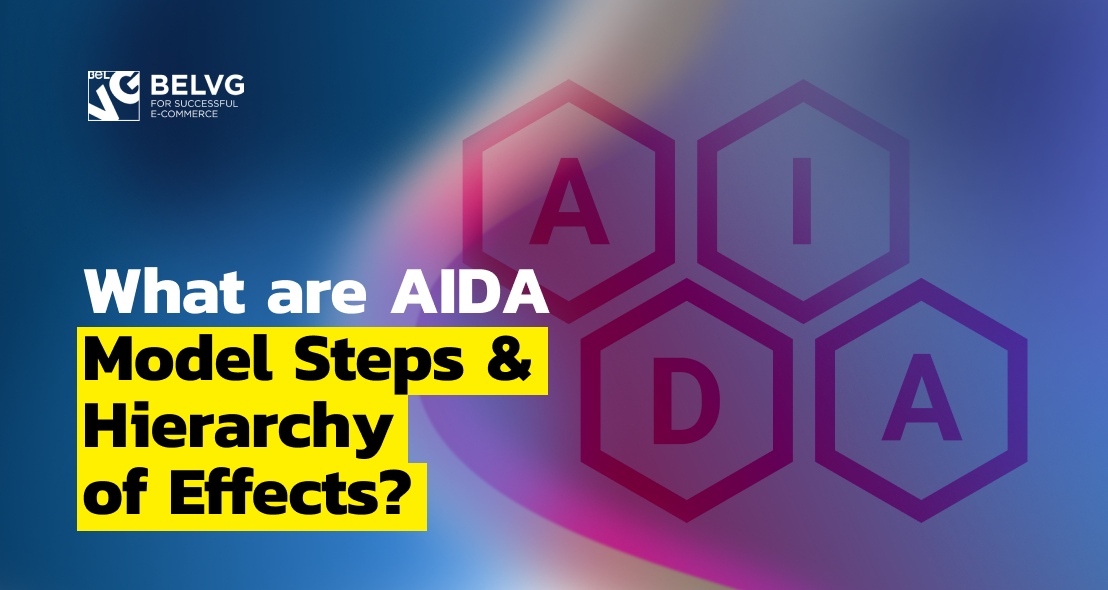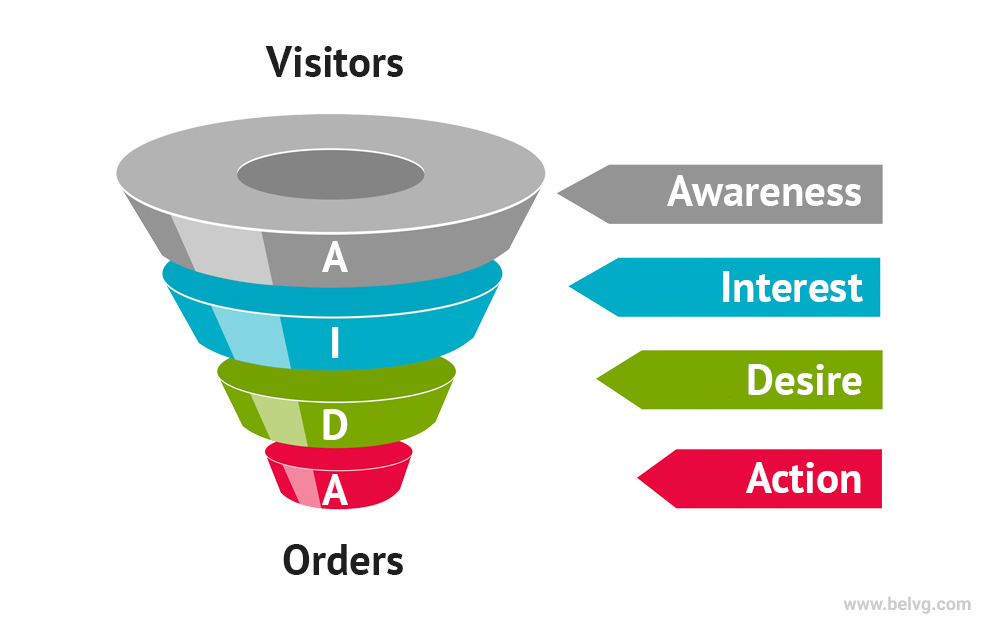
Over the year, this article, explaining what AIDA is and how it works, drew much attention and brought a lot of questions that deserve a more detailed explanation. Also, we would like to describe an alternative marketing model that you may find useful – the Hierarchy of Effects.
What is the AIDA Model in Marketing?
What is AIDA Model’s Origin?
What are the AIDA Model’s Steps?
What is the Hierarchy of Effects Model?
What are the Steps in the Hierarchy of Effects?
What is the AIDA Model in Marketing?
AIDA is a four-step marketing strategy designed to help a retailer to understand customers’ minds. This model explains how to turn visitors into customers by following certain steps. AIDA stands for Attention, Interest, Desire and Action [1]. These are the names of the steps a retailer should do to generate sales efficiently, and also the process a customer goes through while deciding to purchase a product.
The AIDA model is a foundation of marketing. Missing one of the steps listed below may have a greater impact on your marketing strategy effectiveness than you can imagine – and this impact is highly unlikely to be positive. However, if your website is not an ecommerce but information or news site [2], you need to remember that the Action step can be omitted in your case.
The AIDA formula is also a valuable tool in the evaluation of public relation campaigns’ success and effectiveness. It works perfectly for ecommerce and can also help you analyse the results of the product presentation in your online store. If you carry out marketing research after using the AIDA technique, it can be helpful in collecting the necessary data for your advertising messages and emails.
What is AIDA Model’s Origin?
AIDA model was first introduced back in the late 19th century – in 1898 [3]. There have been just a few changes to the original idea, and since the day it was created, the AIDA model has remained an influential marketing concept. First, the American businessman Elmo Lewis established the original version of this model to optimize the workflow for his sales managers. He wanted to set certain rules that they had to follow while talking to a client about a product.
Elmo Lewis has become a pioneer in this kind of a marketing and advertising strategy. Having years of rewarding experience in sales under his belt, Lewis used AIDA primarily for the training purposes to ensure the efficiency of his employees. At the same time, when he realized that this concept works well and leads to an increase in sales, he decided to share this knowledge with the world.
Lewis published articles and also explained his marketing concepts at the seminars in the leading universities of the United States. Back in a day, AIDA was mostly focusing on the direct communication between a seller and a potential buyer but today, after more than 100 years, this formula was proven especially useful in digital marketing.
Let’s take a closer look at all the AIDA steps and learn how to use them in the ecommerce business.
What are the AIDA Model’s Steps?
How does Attention in AIDA Marketing Model Work
Attention step has another name which is also commonly used – Awareness. The main idea sounds quite simple — it is time to catch potential customers’ attention. However, in practice, it is not that easy. Today’s customers have seen so much, they are targeted with thousands of advertisements in social media, on the radio, tv and even strolling along the street. They see more ads in one day than someone sixty years ago saw in a lifetime.
You need to come up with something truly catching to make them notice your brand or something so unusual in its simplicity that it makes them curious. Customer’s curiosity is a retailer’s best friend. If you find the right approach to trigger it, it will win the hearts for you.
The attention is not easy to attract and even more difficult to keep. We have prepared some helpful tips for you to use besides selling the interesting product, presenting useful content and posting creative pictures:
- Check the loading time of your website pages. Patient customer who will be loyally waiting for your homepage or list of product to load for minutes is an unrealistic dream. According to the statistics, an average customer closes the link after three seconds of waiting. An online store owner needs to make sure that the website is fast or be ready to face the negative reviews of unsatisfied customers.
- Optimize your webstore. Product pages are usually the first pages of you webstore that customers visit. It is especially critical to make them look unique. However, do not overuse bright stylish elements since not all of your customers will appreciate it, especially if your target group is Generation X or Baby Boomers. The online store has to stay convenient and easy to use, the pretty picture is not everything.
- Use SEO-optimization. Everything from keywords to alts and titles should be taken care of. They may seem to be minor details but all of them should correspond to reality. If you sell red t-shirts do not use “blue trousers” in a page description. Customers will not appreciate it if they get the feeling that you do not mind misleading them just to increase your traffic or be seen better by Google bots.
How to Draw Interest by AIDA Marketing Model
Interest boosts sales. Drawing customers’ attention is just the first act of the battle, after they come to your website, you have to make sure they find it interesting enough to stay there. First of all, you need to tell them more about the product that you sell. Even if they are already familiar with it, it will show them that you put some effort creating a description.
Another essential thing in your to-do list is to tell the customers more about your brand. Sharing the company’s history, core values and the information about the team members, a retailer can show a customer that there are real people behind the brand. It causes interest and makes customers feel a connection with the company they may buy from.
When the attention is yours, you can take advantage of the following tips to generate customers’ interest:
- Define your target audience. Different kinds of products attract different groups of customers. In order to develop your interest-keeping strategy, you need to take into account several factors, including age, gender, and even level of education of your customers. A retailer has to learn the shopping habits and preferences of a client to provide the best service.
- Show how your products solve customers’ problems. Most of the people want to believe that the product they buy will make their life in some way better. When explaining how useful your product is, do not forget that customer of the 21st-century relies on pictures and videos more than on mere words. Well-presented content is good, but content backed by attractive images is better.
What is Desire in AIDA Model?
At the Desire step of the AIDA model, you should come back to your product page and be very meticulous. Every item should have a detailed description, high-quality macro photos, and preferably also videos to show how the product commonly looks in action. Many people avoid online shopping because they do not want to buy something that they did not touch or see in reality. They are afraid that the quality or look will be different from what they see online. Providing them with all the possible information and good pictures is the best you can do to create a comfortable shopping environment.
Besides that, customer reviews can do a lot and make your company and the product look more credible. It is a good idea to motivate people who already purchased something at your store to leave reviews. You can suggest them some small gifts or discount for sharing their experience in working with you in the comments. It does not mean that you bribe them to make them say how good your company is – they can also leave feedback with possible improvements. Some justified criticism in the comments if it does not go too far is not necessarily a bad thing – it shows people that you let them see not only praising your brand feedback and makes them trust the positive reviews more.
What is Action in AIDA Model?
Action is the last step. Let’s say you have customers’ attention, you also made them interested, and they have a desire to purchase your product. Your company has almost become a winner! At the Action step you have to use a powerful marketing tool – call to action buttons – correctly. You need to make sure that “Add to cart”, “Buy now” (or button with any other action you want your customer to perform on the page) are not hidden. They need to be visible and easy to use.
If there is a lot of content or pictures on the page, there should be at least a few call-to-actions. The location of these buttons on the page can vary but there should be one in the bottom for sure because it is where people expect to find contact forms or live chats. Call-to-actions should be noticeable, big enough, bright and attractive.
What is the Hierarchy of Effects Model?
The AIDA model is the one you commonly see in the standard marketing books but there are also other helpful marketing strategies that can be applied. Some of them are widely known, some are less popular. While AIDA does not have a specific focus and can be used almost in any marketing activity, the Hierarchy of Effects is a marketing model that deals primarily with advertising and how it influences customers’ determination to buy a product [4].
Basically, the Hierarchy of Effects works similar to AIDA model and describes how the interaction between a potential customer and product occurs beginning with the learning about this product. Successfully applied, the Hierarchy of Effects should end with a purchase.
While AIDA consists of four steps, the Hierarchy of Effects includes six: Awareness, Knowledge, Liking, Preference, Conviction and Purchase. In some way, it can be said that this marketing model is an extended version of AIDA. Some marketers believe that it is more advanced. Created back in 1961, the Hierarchy of Effects is a brainchild of Robert Lavidge and Gary Steiner which was developed on the basis of AIDA [5].
What are the Steps in the Hierarchy of Effects?
What is Awareness in the Hierarchy of Effects?
Awareness about the product is the beginning step and it is the moment when a customer encounters a product for the first time. It is the most critical step because without it the whole model is not going to work out. The main goal of the Awareness step is to make sure that the target group of customers is informed about the existence of a certain brand and the products it offers. It is closely connected to the next stage – Knowledge.
What does Knowledge mean in the Hierarchy of Effects?
Knowledge is the step when your potential customers learn more about the products, compare them to the offers of the other brands. It is the most competitive stage when the quality, prices, product’s look and other factors are critically evaluated. A retailer’s task here is to make sure that a customer can easily get access to any kind of information about the products.
What is Liking in the Hierarchy of Effects?
Liking in the Hierarchy of Effects is sometimes also known as an Affective stage. It is the time when a brand establishes an emotional connection with a customer. This stage is about making people feel something about your company and the products you sell. If everything goes as planned, the liking stage paves the way to the customer’s commitment to the brand.
What is a Preference in the Hierarchy of Effects?
Preference is the only step which is not necessarily needed to be a part of your marketing strategy. After all, someone may still be not fully convinced that becoming your customer is the right thing to do, they may still have some doubts and do not see clearly an advantage of picking you over your competitor. Your goal here is to check out the deals and offers on the websites of your competitors to make sure that there is nothing that can tip the scale to their benefit.
What is Conviction in the Hierarchy of Effects?
Conviction is basically breaking the final doubts of a customer about purchasing the product. They see the advantages clear, happy with the way this product looks and its quality. Nothing else stops them from pressing the “Check out” button.
What is the Purchase Step in the Hierarchy of Effects?
Purchase is the last step which finally brings you some profit. The efforts and hard work pay off and you not only sell one more item but also hopefully get one more loyal customer who will order more and recommend you to the friends and family. However, this result already depends not only on the success of your marketing campaign but also on the overall satisfaction of a customer with your product in use. If it is as good as you say it is, there won’t be any issues.
Wrapping it up
Developing your marketing or advertising campaign, there is globally not a big difference if you follow the steps of the AIDA model or the Hierarchy of Effects. However, in order to get a better understanding of the marketing business in general and how its concepts work, both models are must-to-know. Also, if you want to evaluate the results of your work, there is no need for you to struggle and reinvent the wheel. Knowledge, when it is put to good use, can move the mountains.
[1] https://en.wikipedia.org/wiki/AIDA_(marketing)
[2] https://en.wikipedia.org/wiki/Website#Types
[3]https://www.forbes.com/sites/shamahyder/2018/10/11/old-school-is-new-school-reconceiving-aida-for-the-connected-consumer/#708e39207815
[4] https://www.investopedia.com/terms/h/hierarchy-of-effects-theory.asp
[5] https://www.academia.edu/23497016/The_Development_of_Hierarchy_of_Effects_Model_in_Advertising








